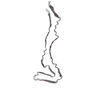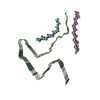[English] 日本語
 Yorodumi
Yorodumi- PDB-8q96: P301S Tau Filaments from the Brains of Tg2541 Transgenic Mouse Line -
+ Open data
Open data
- Basic information
Basic information
| Entry | Database: PDB / ID: 8q96 | |||||||||
|---|---|---|---|---|---|---|---|---|---|---|
| Title | P301S Tau Filaments from the Brains of Tg2541 Transgenic Mouse Line | |||||||||
 Components Components |
| |||||||||
 Keywords Keywords | PROTEIN FIBRIL / P301S tau / Frontotemporal dementia and parkinsonism linked to chromosome 17 / Transgenic mice / Electron cryo-microscopy | |||||||||
| Function / homology |  Function and homology information Function and homology informationCaspase-mediated cleavage of cytoskeletal proteins / negative regulation of intracellular transport / PKR-mediated signaling / regulation of microtubule-based movement / axon extension / axo-dendritic transport / adult walking behavior / mitochondrion transport along microtubule / tubulin complex / negative regulation of tubulin deacetylation ...Caspase-mediated cleavage of cytoskeletal proteins / negative regulation of intracellular transport / PKR-mediated signaling / regulation of microtubule-based movement / axon extension / axo-dendritic transport / adult walking behavior / mitochondrion transport along microtubule / tubulin complex / negative regulation of tubulin deacetylation / axoneme / glial cell projection / intracellular transport / positive regulation of axon extension / regulation of cellular response to heat / positive regulation of microtubule polymerization / axonogenesis / microtubule cytoskeleton organization / neuron migration / microtubule cytoskeleton / cell body / growth cone / microtubule binding / microtubule / postsynaptic density / regulation of autophagy / membrane raft / axon / DNA damage response / dendrite / protein kinase binding / enzyme binding / DNA binding / extracellular region / nucleus / plasma membrane / cytoplasm / cytosol Similarity search - Function | |||||||||
| Biological species |  | |||||||||
| Method | ELECTRON MICROSCOPY / helical reconstruction / cryo EM / Resolution: 3.09 Å | |||||||||
 Authors Authors | Schweighauser, M. / Murzin, A.G. / Macdonald, J. / Lavenir, I. / Crowther, R.A. / Scheres, S.H.W. / Goedert, M. | |||||||||
| Funding support |  United Kingdom, 2items United Kingdom, 2items
| |||||||||
 Citation Citation |  Journal: Acta Neuropathol Commun / Year: 2023 Journal: Acta Neuropathol Commun / Year: 2023Title: Cryo-EM structures of tau filaments from the brains of mice transgenic for human mutant P301S Tau. Authors: Manuel Schweighauser / Alexey G Murzin / Jennifer Macdonald / Isabelle Lavenir / R Anthony Crowther / Sjors H W Scheres / Michel Goedert /  Abstract: Mice transgenic for human mutant P301S tau are widely used as models for human tauopathies. They develop neurodegeneration and abundant filamentous inclusions made of human mutant four-repeat tau. ...Mice transgenic for human mutant P301S tau are widely used as models for human tauopathies. They develop neurodegeneration and abundant filamentous inclusions made of human mutant four-repeat tau. Here we used electron cryo-microscopy (cryo-EM) to determine the structures of tau filaments from the brains of Tg2541 and PS19 mice. Both lines express human P301S tau (0N4R for Tg2541 and 1N4R for PS19) on mixed genetic backgrounds and downstream of different promoters (murine Thy1 for Tg2541 and murine Prnp for PS19). The structures of tau filaments from Tg2541 and PS19 mice differ from each other and those of wild-type tau filaments from human brains. The structures of tau filaments from the brains of humans with mutations P301L, P301S or P301T in MAPT are not known. Filaments from the brains of Tg2541 and PS19 mice share a substructure at the junction of repeats 2 and 3, which comprises residues I297-V312 of tau and includes the P301S mutation. The filament core from the brainstem of Tg2541 mice consists of residues K274-H329 of tau and two disconnected protein densities. Two non-proteinaceous densities are also in evidence. The filament core from the cerebral cortex of line PS19 extends from residues G271-P364 of tau. One strong non-proteinaceous density is also present. Unlike the tau filaments from human brains, the sequences following repeat 4 are missing from the cores of tau filaments from the brains of Tg2541 and PS19 mice. | |||||||||
| History |
|
- Structure visualization
Structure visualization
| Structure viewer | Molecule:  Molmil Molmil Jmol/JSmol Jmol/JSmol |
|---|
- Downloads & links
Downloads & links
- Download
Download
| PDBx/mmCIF format |  8q96.cif.gz 8q96.cif.gz | 61.9 KB | Display |  PDBx/mmCIF format PDBx/mmCIF format |
|---|---|---|---|---|
| PDB format |  pdb8q96.ent.gz pdb8q96.ent.gz | 45.6 KB | Display |  PDB format PDB format |
| PDBx/mmJSON format |  8q96.json.gz 8q96.json.gz | Tree view |  PDBx/mmJSON format PDBx/mmJSON format | |
| Others |  Other downloads Other downloads |
-Validation report
| Arichive directory |  https://data.pdbj.org/pub/pdb/validation_reports/q9/8q96 https://data.pdbj.org/pub/pdb/validation_reports/q9/8q96 ftp://data.pdbj.org/pub/pdb/validation_reports/q9/8q96 ftp://data.pdbj.org/pub/pdb/validation_reports/q9/8q96 | HTTPS FTP |
|---|
-Related structure data
| Related structure data |  18269MC  8q92C M: map data used to model this data C: citing same article ( |
|---|---|
| Similar structure data | Similarity search - Function & homology  F&H Search F&H Search |
- Links
Links
- Assembly
Assembly
| Deposited unit | 
|
|---|---|
| 1 |
|
- Components
Components
| #1: Protein | Mass: 5961.934 Da / Num. of mol.: 4 / Source method: isolated from a natural source / Source: (natural)  #2: Protein/peptide | Mass: 1039.273 Da / Num. of mol.: 4 / Source method: isolated from a natural source / Source: (natural)  #3: Protein/peptide | Mass: 869.063 Da / Num. of mol.: 4 / Source method: isolated from a natural source / Source: (natural)  |
|---|
-Experimental details
-Experiment
| Experiment | Method: ELECTRON MICROSCOPY |
|---|---|
| EM experiment | Aggregation state: FILAMENT / 3D reconstruction method: helical reconstruction |
- Sample preparation
Sample preparation
| Component | Name: P301S Tau Protein Filament (Tg2541) / Type: TISSUE Details: Human P301S tau filaments extracted from the brains of transgenic mouse line Tg2541 Entity ID: all / Source: NATURAL |
|---|---|
| Source (natural) | Organism:  |
| Buffer solution | pH: 7.4 |
| Specimen | Embedding applied: NO / Shadowing applied: NO / Staining applied: NO / Vitrification applied: YES |
| Vitrification | Instrument: FEI VITROBOT MARK IV / Cryogen name: ETHANE / Humidity: 100 % / Chamber temperature: 277 K |
- Electron microscopy imaging
Electron microscopy imaging
| Experimental equipment |  Model: Titan Krios / Image courtesy: FEI Company |
|---|---|
| Microscopy | Model: FEI TITAN KRIOS |
| Electron gun | Electron source:  FIELD EMISSION GUN / Accelerating voltage: 300 kV / Illumination mode: FLOOD BEAM FIELD EMISSION GUN / Accelerating voltage: 300 kV / Illumination mode: FLOOD BEAM |
| Electron lens | Mode: BRIGHT FIELD / Nominal magnification: 105000 X / Nominal defocus max: 2400 nm / Nominal defocus min: 1800 nm / Alignment procedure: COMA FREE |
| Specimen holder | Cryogen: NITROGEN |
| Image recording | Electron dose: 34.2 e/Å2 / Detector mode: COUNTING / Film or detector model: GATAN K2 SUMMIT (4k x 4k) |
- Processing
Processing
| EM software |
| ||||||||||||||||||||||||||||||||||||||||||||||||||||||||||||||||||||||||||||||||||||||||||||||||||||||||||
|---|---|---|---|---|---|---|---|---|---|---|---|---|---|---|---|---|---|---|---|---|---|---|---|---|---|---|---|---|---|---|---|---|---|---|---|---|---|---|---|---|---|---|---|---|---|---|---|---|---|---|---|---|---|---|---|---|---|---|---|---|---|---|---|---|---|---|---|---|---|---|---|---|---|---|---|---|---|---|---|---|---|---|---|---|---|---|---|---|---|---|---|---|---|---|---|---|---|---|---|---|---|---|---|---|---|---|---|
| CTF correction | Type: PHASE FLIPPING AND AMPLITUDE CORRECTION | ||||||||||||||||||||||||||||||||||||||||||||||||||||||||||||||||||||||||||||||||||||||||||||||||||||||||||
| Helical symmerty | Angular rotation/subunit: -0.83 ° / Axial rise/subunit: 4.75 Å / Axial symmetry: C1 | ||||||||||||||||||||||||||||||||||||||||||||||||||||||||||||||||||||||||||||||||||||||||||||||||||||||||||
| 3D reconstruction | Resolution: 3.09 Å / Resolution method: FSC 0.143 CUT-OFF / Num. of particles: 22760 / Symmetry type: HELICAL | ||||||||||||||||||||||||||||||||||||||||||||||||||||||||||||||||||||||||||||||||||||||||||||||||||||||||||
| Refinement | Resolution: 3.09→94.3 Å / Cor.coef. Fo:Fc: 0.873 / SU B: 15.854 / SU ML: 0.269 / ESU R: 0.163 Stereochemistry target values: MAXIMUM LIKELIHOOD WITH PHASES Details: HYDROGENS HAVE BEEN ADDED IN THE RIDING POSITIONS
| ||||||||||||||||||||||||||||||||||||||||||||||||||||||||||||||||||||||||||||||||||||||||||||||||||||||||||
| Solvent computation | Solvent model: PARAMETERS FOR MASK CACLULATION | ||||||||||||||||||||||||||||||||||||||||||||||||||||||||||||||||||||||||||||||||||||||||||||||||||||||||||
| Displacement parameters | Biso mean: 44.677 Å2 | ||||||||||||||||||||||||||||||||||||||||||||||||||||||||||||||||||||||||||||||||||||||||||||||||||||||||||
| Refinement step | Cycle: 1 / Total: 525 | ||||||||||||||||||||||||||||||||||||||||||||||||||||||||||||||||||||||||||||||||||||||||||||||||||||||||||
| Refine LS restraints |
|
 Movie
Movie Controller
Controller



 PDBj
PDBj